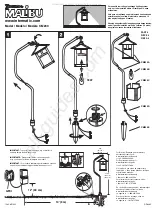
Page 50
10.1.1
Chlorine
The desirable form of chlorine is called Free Chlorine. This form of chlorine is responsible for
the actual sanitation activity in pools and spas. Free chlorine is highly reactive and, once added
to pool/spa water, has a tendency to combine with organic matter in the pool/spa. It quickly
attacks pathogens as well as other bather wastes. When chlorine combines, it chemically
changes. The chlorine binds to organic matter and is referred to as Combined Chlorine.
Combined Chlorine is responsible for eye burn and skin irritations. Total Chlorine is the sum of
Free Chlorine and Combined Chlorine. If a strong chlorine odor is noted, it is due to an excess
of Combined Chlorine. It is important to test Total Chlorine as well as Free Chlorine. If there is a
difference greater than 0.2 ppm (mg/L), a shock treatment should be initiated.
During peak chlorine demand (summer months, rainy season or heavy bather usage) it may be
necessary to increase your chlorine output by increasing your output setting. Conversely, during
low chlorine demand, you can decrease your output to a lower setting. For extremely heavy
chlorine demand or to boost your chlorine residual levels quickly, you can supplement with any
type of chlorine or non-chlorine shock containing potassium monopersulfate.
Note: During cold-
water conditions (below 60ºF/15.6ºC) chlorine demand is reduced significantly. For colder
climate regions with sustained low temperatures, contact your local pool professional for proper
pool winterizing instructions.
10.1.2
pH
pH is a term used to refer to the degree of activity of an acid or base in the water. A low pH,
acidic or corrosive water contributes to eye and skin irritation as well as damage to pool
equipment. A high pH will result in scaling, cloudy water and ineffective sanitation. Improper pH
also contributes to the strong smell, red eyes and dry itchy skin conditions usually associated
with “too much chlorine”.
10.1.3
Total Alkalinity
Total Alkalinity refers to the ability of the pool water to resist a change in pH. It helps manage or
control the pH in the pool. The desired range is 80 to 100 ppm (mg/L). Low alkalinity is
aggressive or corrosive and causes the pH readings to fluctuate (pH bounce). High alkalinity
may cause cloudy water and scale forming conditions. Your Digital Nano/Nano+ does not affect
Total Alkalinity. Factors changing this measure are ancillary chemicals added to the pool and
“out of balance” make-up water.
10.1.4
Calcium Hardness
Calcium Hardness is a measure of calcium content in the water. If the calcium content is too
high, calcium can drop out of solution; forming scale on equipment. A low level will cause the
water to become corrosive as the water tries to naturally form equilibrium. This means the water
will “leach” minerals from everything it meets. Damage to equipment and unpleasant swimming
conditions result. Your Digital Nano/Nano+ does not change Calcium Hardness. Factors
changing this measure are ancillary chemicals added to the pool and “out of balance” make-up
water.
10.1.5
Cyanuric Acid
Cyanuric Acid acts as water
“Stabilizer” or “Conditioner”. This chemical goes by either trade
name and allows your chlorine residual to last longer by protecting it from the UV rays of the
sun. With low Cyanuric acid, chlorine can be used up just as quickly as it is generated. Check
local commercial codes for maximum acceptable Cyanuric acid levels in commercial projects.
Note: For indoor pools, it is not necessary to maintain a stabilizer level to protect the chlorine
from the UV rays. However, it is recommended to maintain a minimal 15 ppm (mg/L) to protect
metallic fixtures from possible corrosion.




































